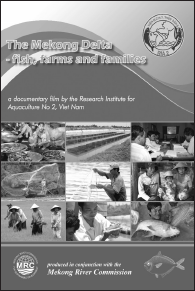Mekong News - Archive
January - March 2007
Issue 2007/1
In this issue:
- Council approves new MRC programmes
- Invertebrate guide adds to MRC knowledge base
- Roads and floods to exist in harmony
- MRC shares hydropower ideas at energy conference
- Denmark provides new funding for BDP2 and EP
- Finland supports basin planning through IKMP
- Navigation priorities on the table
- Warnings the theme of 5th Flood Forum
- Fisheries films bring Mekong’s richness to life
- Upcoming events
Council approves new MRC programmes
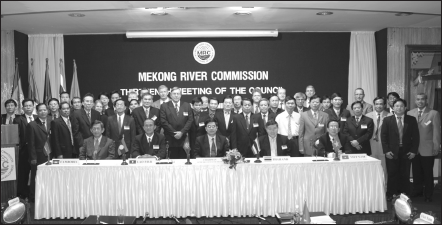
Council members, country delegates,
donors and partners at the 13th Council
Meeting.
Two new MRC programmes got the green light from the MRC Council at its 13th Meeting held in Ho Chi Minh City on 12 December 2006. MRC Council members said that it was time the MRC took a leading role in drought management at a regional scale and the new Drought Management Programme would address this.
Council also approved the Information and Knowledge Management Programme (IKMP) for fundraising. The IKMP is an expansion of the work performed by the MRC Technical Support Division and covers all data management activities including the MRC Portal.
Other business discussed included the launch of Phase 2 of the Basin Development Plan (BDP2) and an extension to the Water Utilisation Programme (WUP).
BDP2 will see the preparation of a rolling Integrated Water Resources Management-based Basin Development Plan; the identification and short listing of a portfolio of programmes and projects; better assessment tools; an improved knowledge base; and enhanced capacity for planning and enhancement of regional cooperation.
The WUP extension is primarily intended to build national capacity in the implementation of the Decision Support Framework (DSF) modelling software and the technical guidelines for the Procedures for Maintenance of Flows on the Mainstream and the Procedures for Water Quality, as well as continuing discussions on these guidelines and maintaining the DSF applications.
H.E. Dr Cao Duc Phat, MRC Council Chairman for 2006-2007, Minister of Agriculture and Rural Development and Chairman of Viet Nam National Mekong Committee, said 2007 would be an exciting year for the MRC. The new Strategic Plan 2006-2010 would be in full swing and there would be increased integration of programme work within the MRC Secretariat.
“The MRC has established a firm direction to work toward coordinated sustainable development of the Mekong River and its associated resources and this is underlined in the Strategic Plan,” he said.
“By adopting an integrated water resources management approach to our work we are anticipating a more efficient and productive working environment which will bring about tangible results in our countries.
” At the 11th Donor Consultative Group, held on 14 December 2006, donors heard of a likely commitment by Belgium to support the newly formulated Drought Management Programme or a Hydropower Programme.
This meeting was also a first step in incorporating development banks into fuller participation. Representatives from the World Bank and the Asian Development Bank (ADB) spoke as participants for the first time at a Council meeting. Dr Cao Duc Phat said Council recognised the effort made by the MRC Secretariat in engaging with the banks for joint activities such as the World Bank and ADB’s Mekong Water Resources Partnership and the ADB’s Greater Mekong Subregion Programme (GMS).
The meeting heard that very successful fundraising efforts by the MRC Secretariat in recent years had ensured the MRC’s financial status was sound and that increasing contributions from the Member States had moved it well along the path to increased riparianisation and country ownership.
There was also discussion among donors and the Member States on the preliminary findings of an MRC organisational review.
Invertebrate guide adds to MRC knowledge base

Dr Narumon Sangpradub (right) and
Mr Boonsatien Boonsoong work on the guide.
Scientists working in the Lower Mekong Basin now have a valuable new tool to help them identify river organisms for their research or biomonitring work.
The MRC’s Environment Programme has produced a new publication – A Guide to the Identification of the Invertebrate Fauna of the Mekong – which sets about filling an important gap in biological bibliography.
While everyone is familiar with the more prominent creatures in the Mekong, such as the Irrawaddy dolphin and the Mekong giant catfish, in fact the bulk of the river’s animal life comprises innumerable types of worms, snails, beetles, crabs, spiders and other bugs, which biologists group collectively as invertebrates.
While there is literature that covers fauna of the Lower Mekong Basin countries, there has been nothing which specifically catalogues or describes the fauna of the Mekong in detail and provides zoologists with the detailed information they need to identify invertebrates accurately.
In order to rectify this problem the MRC’s Environment Programme commissioned biologists from the Khon Kaen University, Thailand to produce a guide to the identification of the invertebrate fauna of the Mekong. The work was undertaken by Dr Narumon Sangpradub, an associate professor in the Department of Biology, and her colleague Mr Boonsatien Boonsoong who is a PhD student in the department.
The guide, which took a year and a half to compile, was tested in the Member States before it was finalised. The new guide is intended for laboratory use and contains a series of “identification keys” and over 300 line drawings that will provide a practical tool for biologists from throughout the region to use in their research. It will also help to ensure that biomointoring activities in the Lower Mekong Basin are based on accurate identification of diagnostic invertebrate animals.

The guide features detailed line drawings
of specimens such as this water mite.
Invertebrates play an important role in the lives and livelihoods of the people of the Lower Mekong Basin. They are a vital source of food, particularly of animal protein, and form a significant portion of the Mekong’s prodigious fishery.
On the downside, some invertebrates, such as blood flukes and tapeworms, are harmful parasites that infect humans and livestock, while others are secondary hosts to other pathogens.
From the development perspective, invertebrates are one of the groups of animals and plants that can be used to help monitor the ecological health of the river systems. Their widespread distribution, relatively long life (ie months to years) and sensitivity to environmental stresses means that they can be used to observe overall condition over a broad range of aquatic habitats.
The publication is part of the MRC’s commitment to build a knowledge base on the biology and ecology of the Mekong and to develop tools for monitoring the environmental health of the river system. The guide was published with financial assistance from UNDP and the governments of Denmark and Sweden.
Roads and floods to exist in harmony
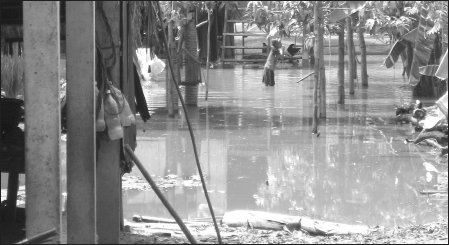
Roads and other structures can sometimes
form artificial barriers to flood waters.
The Mekong River Commission has joined forces with the Delft Cluster, UNESCO-IHE, and the World Wide Fund for Nature to develop guidelines for the planning and design of roads in the floodplains of the Lower Mekong Basin.
Heavy floods can severely damage infrastructure, including roads, but, road development can also have a considerable effect on the floods. Roads can fragment wetlands and interrupt the natural flow of water, sediments, nutrients and aquatic life, and consequently have an impact on the benefits brought by the natural flood cycle.
The challenge is to make future road structures more flood-resistant and provide greater through-flow capacity while reducing their negative environmental impacts.
The “Roads and Floods” project is developing guidelines for better planning and road design. These guidelines are meant to define (or redefine) new standards for the planning, design and construction of roads and to develop environmental impact assessment methodologies. The results will be integrated into the work of the MRC's Flood Management and Mitigation Programme (FMMP).
The project consists of three strongly interrelated components – a scientific component, a policy component and integration with the FMMP.
The scientific component consists of several technical analyses that are integrated into a policy analysis. In the technical analyses, hydraulics and damage at pilot sites in Cambodia and Viet Nam will be monitored and analysed during the 2006 and 2007 flood seasons, providing input for an inundation model and damage assessment.
The findings at the pilot sites will be scaled-up to sub-floodplain areas to analyse road and flood interactions, using the inundation model.
In some cases, there will be analysis of the interaction and trade-off between flood risk and damage, along with the structural durability, economic and financial efficiency, and hydrological and environmental effects. This will form the basis for recommendations to improve guidelines for road planning and design.
The policy component will translate the findings of the scientific component into policy recommendations and ensure that those recommendations are known and understood by the key stakeholders. Line agencies and development bank representatives in Cambodia and Viet Nam, led by the respective National Mekong Committee, will discuss the political and institutional recommendations.
The integration component will ensure that results are made available to the FMMP's Regional Flood Management and Mitigation Centre in Phnom Penh and that they are accessible to others.
The project results will benefit Cambodian and Vietnamese line agencies, the National ministries and provincial authorities responsible for planning, construction and maintenance of national roads, as well as development banks that fund infrastructure projects. The results of the “Roads and Floods” project will also be shared with agencies in Lao PDR and Thailand.
(Information for this article was sourced fromUNESCO-IHEs newsletter)
MRC shares hydropower ideas at energy conference

Posters showed how development can
co-exist with a healthy environment.
Historically hydropower development has always been high on the MRC agenda, MRCS CEO Dr Olivier Cogels told the International Symposium on Water Resources and Renewable Energy Development in Asia conference held in Bangkok in December 2006.
However, he explained, this development had to be well coordinated, equitable, peaceful, carefully planned, and must minimise social and environmental impacts. Most importantly, it must be for the benefit of all of the people of the basin, especially the poorest.
MRC was well represented at the conference and accompanying exhibition and presented papers covering the potential and existing situation of hydropower development in the Lower Mekong Basin, hydrological studies in an international river basin and current flood forecasting methods and improvements needed.
The exhibition also provided an opportunity to introduce a new joint initiative being undertaken by the The Asian Development Bank, the MRC and the World Wide Fund for Nature Living Mekong Programme. The three bodies have formed a taskforce to assess the needs and demands for Environmental Criteria for Hydropower Development in the Greater Mekong Subregion (GMS).
The aim is to engage the hydropower industry, the governments of the GMS countries and international and local stakeholders to improve planning frameworks for hydropower so that the manifold benefits will outweigh any negative impacts. The partners believe that a more integrated approach in the planning process will assist GMS countries in environmentally sustainable planning for future development of hydropower resources and advance the capacity to balance economic, social and environmental dimensions in the interests of sustainable development.
It will also help the hydropower industry by helping to identify which projects would have the least impacts, and which sites could provide the best development opportunities.
Denmark provides new funding for BDP2 and EP
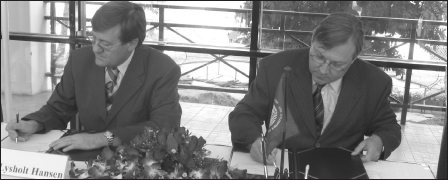
H.E. Mr Peter Lysholt Hansen (left)
and Dr Olivier Cogels sign the agreement.
On 6 December 2006 the Mekong River Commission and the Government of the Kingdom of Denmark signed an agreement worth 52.5 million Danish Kroner (around $US9 million) to fund the second phase of the MRC's Basin Development Plan (BDP2) and to continue the work of the Environment Programme.
The new funding agreement was signed by H.E. Mr Peter Lysholt Hansen, Ambassador of Denmark to Viet Nam and Dr Olivier Cogels, Chief Executive Officer MRC Secretariat at the MRC Secretariat headquarters in Vientiane. Under the terms of the grant 45 million Danish Kroner will go to the BDP2, while 7.5 million will go to the MRC's Environment Programme. The grant will extend to 2010.
The BDP2 programme will formulate a joint development rolling plan which takes a basin wide perspective of shared water and related resources and aims to manage and develop them in an integrated, sustainable and equitable manner for the mutual benefit of the member countries.
BDP2 will also further develop the BDP’s established knowledge base and its assessment tools and see these used effectively both within the MRC and the National Mekong Committees (NMCs).
It will build capacity at MRC and NMC levels for integrated water resources management (IWRM) planning and develop, prioritise and promote a portfolio of programmes and projects to be implemented in Member States in a coordinated way.
The EP will use the Danish funds to expand its work in providing data on the status of changes in water sediment quality, aquatic ecosystems and social and economic conditions. It will establish an appropriate basinwide environmental monitoring system and continue its work toward encouraging joint and sustainable development, thus avoiding any transboundary issues. It will also develop a methodology for environmental flows assessment in the Mekong River basin and provide scientific data and information on the relationship between flow regimes (quantity and quality) and environmental assets in the Mekong River Basin.
Finland supports basin planning through IKMP
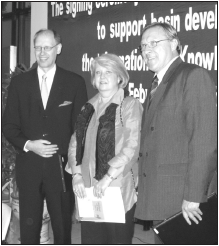
H.E. Mr Backstrom (left),
H.E. Ms Marjatta Rasi, Finnish Under
Secretary of State and Dr Cogels.
The MRC and the Government of Finland have signed an agreement worth Euro 6,728, 010 (US$8.679 million) to support basin development planning through the MRC’s new Information and Knowledge Management Programme (IKMP).
The new funding agreement, which will be spread over four years, was signed by H.E. Lars Backstrom, Ambassador of Finland to Thailand, Cambodia, Lao PDR and Myanmar and Dr Olivier Cogels, CEO MRCS at the Secretariat in Vientiane on 8 February 2007.
This agreement aims to support the IKMP, with specific emphasis on its relation to basin development planning.
The IKMP is designed to facilitate access to and use of the data, information and decision support tools necessary to promote and coordinate sustainable development of water and related resources in the Mekong Basin.
It incorporates exchange and sharing of data on water resources, hydrology and meteorology as well as all other resources required to implement the work of the MRC’s programmes, such as management of high quality and integrated MRC-IS databases, and the capacity to analyse and interpret data.
One of the IKMP’s most powerful modelling tools is the Decision Support Framework, which can provide the MRC with the capability to investigate environmental and socio-economic impacts of changes in the quantity and the quality of flows in the Lower Mekong river system, brought about by changing circumstances within the basin.
This type of basin planning is essential if the MRC’s Member States are to make informed decisions about sustainable development.
Navigation priorities on the table
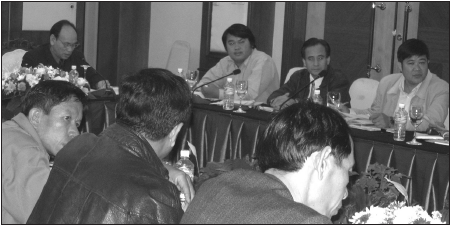
Participants discuss their priority
needs for navigation at the meeting in Vientiane.
The MRC Navigation Programme (NAP) commenced work in 2006 and is now ready to put its planned programme activities into action.
The NAP’s first challenge is to try to fulfil some of the long awaited plans of the Member States and in order to achieve this, during January 2006, it held four National Workshops in each Member State on the Navigation Implementation Plan and Project Appraisal and Identification. These workshops were designed to find out what member countries have decided are their navigational priorities and how the NAP can help them.
Based on these priorities and based on how they fit in with the original NAP Activities, the final projects will be identified and approved during the Regional Workshop which will be held on 26-27 March 2007.
One of the NAP’s first steps is the implementation of its project on “Procurement, Installation and Training on Aids to Navigation on the Mekong River between Phnom Penh Port and the Cambodia-Viet Nam Border”.
The first buoy is due to be placed in early April and the project is expected to finish at the end of 2007.
The NAP is a US$22 million programme which is currently funded to the amount of US$ 6 million by the Belgian Government.
Warnings the theme of 5th Flood Forum
CALL FOR PAPERS, EXHIBITIONS A call for papers both from member countries and others and a paper submission form can be downloaded from the MRC website http://www.mrcmekong.org/MRC_news/upcoming_events.htm Organisations, companies, or institutions are invited to exhibit their activities, or products at an exhibition which will accompany the 5th Annual Mekong Flood Forum. The registration form for participation in the exhibition can be also downloaded from the MRC website. |
The MRC’s Regional Flood Management and Mitigation Centre (RFMMC) will conduct the 5th Annual Mekong Flood Forum from 17-18 May 2007 at the Rex Hotel, Ho Chi Minh City, Viet Nam.
The theme for this year's forum is: “Improving Inputs towards Mediumterm Flood Forecasting and Early Warning in the Mekong Basin”. This reflects the MRC's Strategic Plan 2006-2010 which states that a key challenge of the RFMMC is to improve data collection and information exchange among the riparian countries and the MRC, as well as with other users or donors.
The Forum aims to raise the awareness of the current state of data collection, transmission and exchange (especially, water level and rainfall) at the national and regional levels in the Mekong Basin.
It will also provide participants with the opportunity to discuss the database systems and tools used for dissemination of the flood forecasting and early warning products that are produced by the MRC-RFMMC and the National Centres of the MRC Member States.
Representatives from the MRC's four Member States will each present a report on how their countries fared in the 2006 Flood Season and the lessons they learned and there will be presentations on the flood experience in the Mekong Basin from MRC's Dialogue Partners, China and Myanmar.
There will be group discussion sessions on MRC plans for new short and medium term forecasting systems at the RFMMC and what it will take to make these more efficient. In particular, these talks will focus on data inputs in several areas of meteorology and weather, in water levels, in effective early warning and in flood preparedness.
Other topics will include data and information requirements for emergency management, relief and reconstruction. This forum will give ample time for in-depth debate and the organisers are anticipating some innovative solutions and suggestions.
Participants will come from Cambodia, Lao PDR, Thailand, Viet Nam, China, Myanmar, MRC Programmes, donor agencies, the scientific and international community, international and national civil society organisations, companies and local communities.
Contact: Bob Pengel,
Tel: (855)-23-726-622; Ext: 1012
amff5@mrcmekong.org
Fisheries films bring Mekong’s richness to life
The MRC’s Fisheries Programme is well known for its excellent communications products – many of which are produced in riparian languages.
Now it has moved into the medium of movies to spread the word about the importance of the Mekong fisheries and the work of the MRC to maintain them.
A new documentary – The Mekong Delta: Fish, Farms and Families – produced by the Research Institute for Aquaculture No 2 (RIA2) in Ho Chi Minh City in 2006 takes a close look at fish resources of the Mekong Delta, as well as aquaculture and breeding programmes being undertaken by the Vietnamese Department of Fisheries. The film, which has already been shown on Vietnamese television, has been produced in Vietnamese and English and can be ordered from the Fisheries Programme or RIA2.
Similar films on the fisheries of Thailand and Lao PDR have also been undertaken over the past year and are now in their final stages of production. They will be available soon.
The documentary on the Cambodian fishery Where There’s Water There’s Fish was completed in 2003 and was produced in English and Khmer. It has proved to be very popular and has been shown many times on Cambodian television channels.
25th Meeting of the MRC Joint Committee
9-10 May, Siem Reap, Cambodia
Email: schiefer@mrcmekong.org
The International Conference on Water and
Flood Management
12-14 March 2007 Dhaka, Bangladesh
www.buet.ac.bd/icwfm/
Fifth Annual Mekong Flood Forum
17-18 May 2007, Ho Chi Minh City, Viet Nam
Email: amff5@mrcmekong.org
River Basin Management 2007 Conference
23-25 May 2007, Kos, Greece
http://www.unesco.org/water/water_events/Detailed/1389.shtml
International Network of River Basin Organisations
7th World General Assembly
7-9 June 2007, Debrecen, Hungary
Email: inbo@wanadoo.fr
2nd IASTED International Conference on
Water Resources Management
20-22 August 2007, Honolulu, Hawaii, United
States
http://www.unesco.org/water/water_events/Detailed/1375.shtml
World Water Week
12-18 August, 2007, Stockholm, Sweden
www.worldwaterweek.org
Choose a newsletter:

